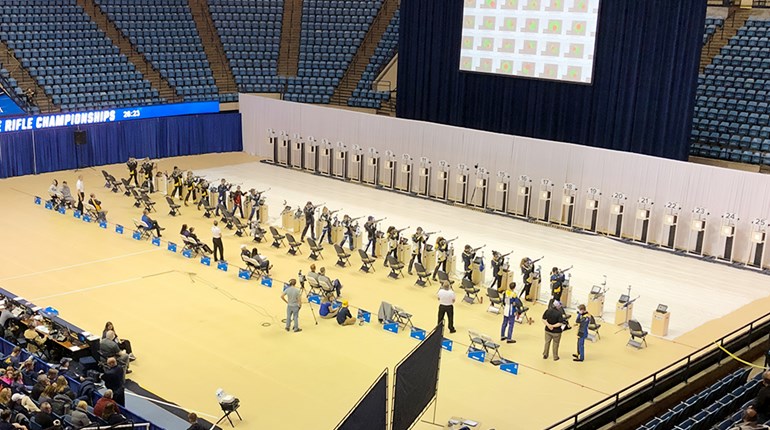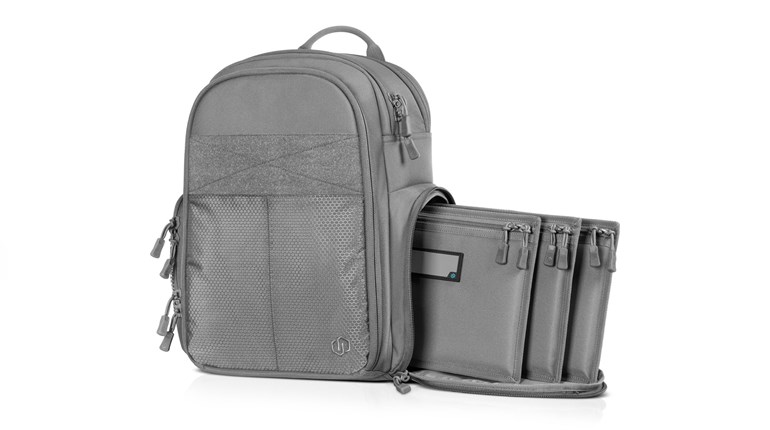
From the vault: Our coverage of the 2005 NRA Smallbore Rifle Silhouette Championship. As published in the September 2005 issue of Shooting Sports USA.
Hats Off To The Chef
Story and Photos by Rory K. Aikens
The targets systematically fell, one after another with methodical precision. Agustin Sanchez, Jr., who was only 21 at the time, is known for his ability to focus on the target he is shooting—allowing nothing else to enter his mind.
"I always think the shell I have in the chamber is the first one. There are no targets after, and no targets before, only the target I am shooting," Sanchez said. "It's all in the mind."
As the three-day championship began in Phoenix, Arizona, on a warm June morning, competitors from 14 states and three countries knew Sanchez was the man to beat. Last year Sanchez swept all four national silhouette championships in smallbore and high power rifle. Everyone was wondering if this amazing young shooter, originally from Tijuana, Mexico, could step up and do it again.
During the first day of the NRA National Smallbore Silhouette Championships, Sanchez came up against Troy Lawton, a veteran who has won his share of championships over the years. During the first match, Lawton and Sanchez tied with a score of 37 each. Cathy Winstead, another veteran champion, shot a 36 to keep in contention with the two leaders. The three-day, three-match national championship shoot was shaping up to be a tight race.
SANCHEZ FINDS PERFECTION
On the second day of competition, temperatures soared well into the triple digits and a breeze picked up. Beads of sweat seemed to vaporize as soon as they formed. Dust devils swirled and erratically raced across the saguaro-studded landscape at the Ben Avery Shooting Facility.
Shooting conditions weren't necessarily bad, they just changed from moment to moment. Flags would stiffen in the wind, then suddenly drop like wet spaghetti. Winstead shook her head and remarked, "It's boiling out there," referring to how the heat-induced mirage was making the targets appear to dance.
Despite less-than-perfect conditions, Sanchez was relentless. One at a time, he slammed the targets. It was like watching Randy Johnson when he pitched his perfect game. Only better in a way—Sanchez was delivering nothing but strikes.
With absolutely no change in his expression, Sanchez popped each target down in quick succession. Five chickens up, five chickens down—the turkeys and pigs met a similar fate. At 100-meters away, you needed to squint in the bright desert sun to watch the rams fall one after the other. When the last shot was fired, Sanchez had reached his quest for perfection—he shot 40 out of 40.
This isn't the first time this amazing young man has attained such a feat. "I shot a perfect 40 once before in Mexico in 2001, but this is the first time I have done it in competition here in the United States," Sanchez said.
Of all the records and titles he has attained during his meteoric career, shooting 40 is his proudest accomplishment. Why? The quiet-spoken young man just shrugs his shoulders and says, "It's the best anyone can shoot."
Sanchez, who is attending chef's school, said he still wants to break more records in both smallbore and high power. He also wants to open his own business—a restaurant, of course.
SILHOUETTE SHOOTING IS A TEAM SPORT
For Sanchez, the records are not just his alone. "I couldn't do it without my coach, Tony Tello. I just shoot where Tony tells me to."
You can see the teamwork on the shooting range during the competition. The shooting bays might be full of other competitors firing away, but when you watch the team of Sanchez and Tello, it's evident that this pair is in a world of their own. Nobody else exists, nothing except the current target.
After every shot, Sanchez automatically looks at Tello. The veteran coach provides a quick-but-decisively spoken direction: left, right, up or down—whatever he can discern by watching shot placement through the spotting scope and from checking the flags. The communication is instant. It's like the pair feel compelled to exchange a word or two, and sparingly so, just to convince first-time observers they really aren't telepathic.
Sanchez fires, methodically ejects the spent shell and immediately turns to look at his coach again. It's automatic. It's repetitious. And sometimes, it's perfection. For competitors, it can be daunting.
Lawton shot a 36 and Winstead posted a 34 on the second day, which meant Sanchez went into the final match with a four-shot lead and the psychological advantage—how do you beat perfection?
In the final match, Sanchez kept up his relentless pace, shooting a 38 and leaving the field six shots behind. He handily won the national championship with a score of 115.
"Sanchez is unbelievable to watch. He's a shooting machine," said Jim Hebenstreit with the Hassayampa Gun Club in Phoenix, which hosted the event. The term hosted is, of course, an understatement when club members put in hundreds of hours during the year to make the national championship at the Ben Avery Shooting Facility a reality.
Shooter after shooter commented on how well the event was staged, but there was one common thread: everyone said they have never shot a national competition where the targets were routinely repainted to provide the best sight picture possible.
"I have never seen such a hard-working club. They did an amazing job," NRA Silhouette Match Director Greg Connor said.
SMALLBORE HUNTING RIFLE CHAMPIONSHIP
Tight group is the only description for the Smallbore Hunting Rifle Silhouette Championship. Lawton shot a 34 on the first day, then banged out a 35 on the next two consecutive days for a final score of 104 to lead the competition.
Winstead was a close second. She shot a 34 to tie with Lawton on the first day of competition but then dropped behind by two shots on the second day. Both Lawton and Winstead shot a 35 during the final match. Winstead compiled a 102 total for the three days to come in second overall, but it was more than enough to continue her reign as the national woman champion.
During the first two days of competition, last year's champion, Agustin Sanchez, dropped behind the leader by six shots. He shot a 31 and a 32. On the final match, Sanchez rebounded and shot a 38, which was the highest single match score of the hunter rifle competition.
It wasn't enough. His final score was 101, one shot shy of Winstead.
Lawton, a ballistician for the U.S. Army at Fort Benning, Georgia, talks about powder loads, bullet weights, muzzle velocities and trajectories as naturally as most people talk about the weather. His job with the Army is to test and evaluate ammunition for accuracy and velocity. "Our boys deserve the most accurate ammunition we can give them."
He also talks proudly about the custom-looking camouflage stock of his out-of-the-box smallbore hunter rifle. "I had it done in Realtree's HD green. It's unique. I don't think there is another one like it," he said.
While shooting is a significant portion of Lawton's life, to him, the shooting sports are also about family. "We compete as a family. My wife and son are usually there right along with me, especially in those matches closer to home."
Lawton's son, Kevin, competed in this year's championship in Phoenix in the AAA class. Kevin shot an 80 to take high junior honors in his class.
For Lawton and others, the shooting sports are an extended family. Winstead said everyone has their competitive side, but the matches are as much about the camaraderie as they are about shooting. "We all know each other. The matches are an opportunity to see old friends and make new ones."
IT'S A GIRL'S SPORT, TOO
At age nine, ReAnn Wilson came home from school in Bozeman, Montana, handed her dad a parental permission slip, and said, "Daddy, I really want to do this."
The permission slip was for participation in an air rifle program at her school. Kyle Mobley signed that permission slip for his daughter three years ago, not realizing the direction it would lead the entire family.
For Wilson, the motivation was simple. "I really thought it would be so cool to beat all the boys at something they're supposed to be good at. It's a girl's sport, too, but people don't realize it," ReAnn said.
The coaches for the air rifle program in Bozeman were Chris and Cathy Winstead. They both understand young shooters. Chris began coaching Cathy when she was seven. Now at age 27, Cathy has won her share of national championships and is one of the top shooters in the nation, male or female. She knows what it takes to be a young shooter coming up. "It's a lot of work, but most of all, it's got to be fun or it's just not worth it." Wilson blossomed under the coaching and tutelage of the Winsteads.
Wilson made the state team her first year shooting air rifles. "When she got done, she asked, 'Now what?'" said her dad, adding that her coach, Chris Winstead, was standing there at the time and he quickly responded with one word, "Smallbore."
Wilson and smallbore were a natural fit. The sharp-eyed young shooter had found her calling. Last year, she went to the NRA National Smallbore Silhouette Championships. She tied with another young shooter, Adam Routh. They had a shoot-off. Wilson won and came away as the sub-junior champion her first time out. This year, she advanced to the master shooter class. It should come as no surprise that she came away with both sub-junior titles this year.
While most youngsters are typically introduced to the shooting sports through their dads or grandads, Wilson added a new twist—she introduced her dad to competitive shooting. She also paved the way for her 10-year-old sister, Jenna, to enter the sport.
Chris Winstead is emphatic about the future of this young shooter. "ReAnn is a gifted shooter. She's going to make the national team by age 16."
With a slight smile and a little bit of pride in her voice, Cathy Winstead puts Wilson's accomplishments into perspective. "She's more advanced than I was at that age."

































